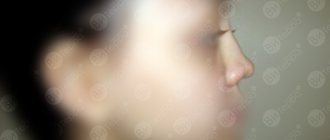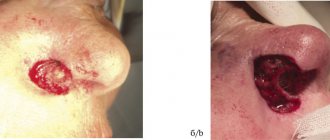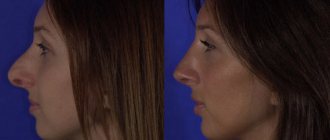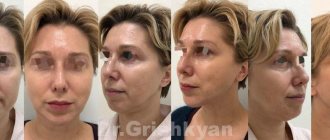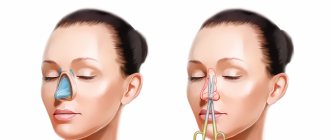Before you decide on such a responsible procedure as surgery to change the shape of your nose, think about whether there are more painless and cheaper ways to bring your nose into the desired shape. We have written a special article on non-surgical methods of rhinoplasty. We advise you to familiarize yourself with it before spending huge sums and going under the doctor’s scalpel.
An operation such as rhinoplasty of the nose is considered a common type of surgical intervention with maximum cosmetic risks. The consequences of nose rhinoplasty are based on the unpredictability of the aesthetic result. And their manifestations can be expected at any stage - during surgery, during rehabilitation and after a certain period. Please note that after rhinoplasty in men, rehabilitation is easier and the risk of negative consequences is less.
In addition to the aesthetic risk, there are negative consequences for the patient’s general health, short-term and long-term side effects. They can manifest themselves depending on the individual characteristics of the patient and with various aggravating factors.
Complications after rhinoplasty
The unpredictability of rhinoplasty lies in the fact that the ideal results on the face immediately after the procedure can be distorted throughout the year. These complications depend on the dynamics and processes of tissue healing. The following organs are involved in the operation:
- bone;
- cartilage joints;
- mucous membrane;
- skin;
- adipose tissue;
- muscle;
- nerves and blood vessels;
- tissue over cartilage and over bone.
And if during surgery a specialist can control the reaction of these organs, then after applying sutures and bandages, some internal processes are inaccessible to the doctor.
Most surgeons violate medical ethics by reassuring the patient that the consequences after rhinoplasty are minimal. Nasal surgeries are complex and with a high probability of a negative outcome for the client. And here not only the distorted shape of the nose can play a role, but also the dissatisfaction of the patient himself from a psychological point of view.
Medical statistics indicate repeated operations in almost 15% of cases. If we take into account the total percentage of all plastic surgeries, then these indicators are significant. And if the surgeon reports with a smile that there are no consequences for the patient, then one can be confident in his incompetence and selfish thoughts of profit.
What factors can influence the consequences after rhinoplasty?
- The professional level of the doctor is not high enough. Such expensive operations require numerous plastic surgery skills. Often, some specialists lack experience, so the failure rates of rhinoplasty are significantly increased. Before selecting a doctor, it is recommended to inquire about his professionalism, the number of successful operations and customer reviews of the clinic.
- Not always all the blame has to be attributed to some inexperience of the surgeon. The patient’s attitude towards the rehabilitation period plays a big role. If he follows the specialist’s recommendations only partially, then the risk of complications and consequences increases significantly.
- The characteristics of the patient's tissues may affect the future appearance of the nose. The nature of scarring of cartilage tissue can be unpredictable. And since the doctor does not have full control over the process, rhinoplasty can lead to sad post-operative changes.
Consequences of surgical rhinoplasty
Unpredictable nasal deformity
Asymmetry of tissue fusion after rhinoplasty is one of the main consequences causing the greatest dissatisfaction among patients. Also, cartilage tissue may undergo complete deformation. This risk belongs to the unforeseen group and also occurs during surgery. Often changes in the nasal septum are affected by osteotomy, in which the cut bone is narrowed, broken or compressed on one side of the nose.
Bleeding
During surgery, the risk of bleeding is minimized. This is facilitated by modern equipment and special medications that slow down blood flow. But in some situations, if blood clotting is poor, severe bleeding can occur, which poses a threat to the patient’s life. Usually, previously undetected blood clotting disorders lead to such consequences. Coagulopathy and fibrinolysis become a dangerous condition in any surgical procedure.
Swelling and hematomas
Tissue inflammation and subcutaneous hemorrhage are part of the natural healing stage. These are inevitable consequences. Injured tissues gradually return to normal. In addition to swelling and bruising, extensive hemorrhages under the lower eyelids and into the eyeball may occur. If the patient does not experience severe complications, there is no partial loss of vision, then such symptoms do not require special treatment.
Infection
The pathogen easily penetrates the blood and lymph, which becomes an excellent medium for its spread throughout the inflamed tissue. As a result, a focus with purulent contents is formed. Subsequently, the patient may experience nasal purulent discharge, fever, severe malaise and other general symptoms of infection. If this consequence is not treated in a timely manner, necrosis of the skin and internal tissues of the nose develops. In such cases, a real threat to the health and life of the patient develops.
Seams
Suture dehiscence may be caused by extensive swelling. If care for such a consequence was incorrect, then in the future the patient will face an unsightly scar or scar in the nose area. Hypertrophic scars cannot be removed with folk remedies or massage. To eliminate such a defect, the patient is offered to use injections with hormones, laser therapy or mechanical dermabrasion.
Consequences of aesthetic rhinoplasty
Drooping of the tip of the nose
During the scarring process, excess tissue accumulates and sinks downward. Also, a drooping tip of the nose is formed due to improper correction. This kind of deformation cannot be eliminated without revision rhinoplasty.
Bulges
The convex parts of the nose are unevenly distributed over the surface. This consequence is based on non-compliance with the rules of symmetry during surgery, due to too large scars after healing and thin skin. If the epithelium goes into the subcutaneous layer during plastic surgery under pressure, a cyst may develop, which must be removed after healing. In rare cases, calluses may form after surgery.
V-shaped nose
This deformation occurs due to improper sawing. If the technique is applied on one side of the nose, it takes on an asymmetrical shape. Improper cutting of the transverse cartilage leads to difficulty breathing. Too much tissue cutting provokes pathological edema.
Consequences requiring immediate surgical intervention
- complications associated with intracranial processes;
- abscesses, stenoses
- intracranial complications;
- perforation of the nasal septum;
- atrophic consequences;
- breathing disorders, its possible stop.
Rhinoplasty: should you be afraid of it?
DOC.UA : Evgeniy Vladimirovich, tell us what is the essence of rhinoplasty and why do patients apply?
Evgeniy Vladimirovich: Nose surgery (widely known as “rhinoplasty”) is considered one of the most popular and most complex plastic surgeries performed for aesthetic purposes. It is performed to change the size or shape of the nose, often in combination with septoplasty (septum correction) to help the patient breathe normally. Rhinoplasty can be performed to remove a hump, change the tip of the nose, or reduce the size of the nose or nostrils. It is also often performed to correct a nasal defect after injury. Rhinoplasty can be combined with other plastic surgeries, such as mammoplasty, cheiloplasty (lip surgery), blepharoplasty, mentoplasty (chin surgery), as well as lipofilling.
DOC.UA: What is the difficulty of performing rhinoplasty?
Evgeniy Vladimirovich: Rhinoplasty is, without a doubt, the most complex and sophisticated operation among all aesthetic interventions. Currently, we can guarantee the desired aesthetic result and high safety by using modern surgical techniques. It is very important that today’s rhinoplasty is not just a reduction of the nose, it is an operation to harmonize facial features and inner world.
Highly qualified specialists select the shape and size, drawing it in advance in 3D format, that is right for you.
DOC.UA: How do clients feel about this type of operation? Are they afraid of her?
Evgeniy Vladimirovich: It should be noted that there are several fairly common myths about rhinoplasty, because of which most people are afraid to undergo this operation.
Myth No. 1
It is not intended exclusively for women, as is often thought: for example, in the United States, almost every fifth client who wants to have rhinoplasty is a man. Among all cosmetic surgeries, the correction of congenital or acquired nasal deformities is the most popular among men. Moreover, male rhinoplasty is very different from female rhinoplasty.
Myth No. 2
The fact that after rhinoplasty your face will be blue and swollen for a long time, and you will be able to go out in public in a month is already a myth, since today modern Israeli technologies, a clean room system and hybrid operating rooms, as well as jewelry techniques allow the patient to recover very quickly, and publication is possible in 7-10 days.
DOC.UA: Could there be serious consequences after such an intervention?
Evgeniy Vladimirovich: Patients after rhinoplasty are afraid of the consequences, because they think that they will “break” their nose, and since the face is a delicate thing, the operation may well affect their health. However, today plastic surgery techniques make it possible to carry out similar operations in a low-traumatic manner, without breaking the nasal bones - without consequences and marks on the face and with safety for health.
Consequences after rhinoplasty: Photo
Deviated septum
Bulges due to cartilage deformation Swelling and tissue hematomas
A separate stage is the restoration of the patient’s normal psychological state after unsuccessful rhinoplasty. Since it is mainly women who are in line for this operation, they are more susceptible to depression and dissatisfaction with their appearance. For women who plan to reduce the negative consequences to zero, laser rhinoplasty is recommended.
What are the dangers of revision rhinoplasty?
Here, a lot often depends not only on the doctor, but also on the patient. Some people know that they cannot have a second procedure unless a year has passed since the first. Despite this, they may deceive the doctor about the date of the previous operation. This significantly increases the risk of serious complications. This fact should not be neglected!
If the patient resists and tries by all possible methods to speed up the secondary operation, then he is at great risk. Often this attitude leads to even more serious negative consequences, such as impaired respiratory function.
One month after surgery after removing the cast
2 weeks after rhinoplasty, the main swelling goes away and bruises under the eyes disappear. The consequences of the operation will no longer be noticeable. After two weeks, you need to come for a consultation, where a photo will be taken after rhinoplasty. You need to be patient.
2 weeks after the operation, the swelling is almost not noticeable externally, but it is still there. If rhinoplasty of the tip of the nose has been performed, then within two weeks you can return to life as usual. After such an operation, recovery is faster, because the bone section was not affected.
Read our special publication “How swelling goes down after rhinoplasty”
After 3 weeks, you also need to take a photo in order to compare the nose before and after surgery. The swelling is still going down, the nose is gradually “deflating”. Although the period is still too short to talk about any results, photos taken at 3 weeks show this eloquently.
1 month after rhinoplasty, the nose begins to take its shape. And although it is still very early to evaluate it, the main swelling goes away at this time. It is at 4 weeks after rhinoplasty that you need to make an appointment with a plastic surgeon. At this time, a photo is taken to evaluate the result. After a month, you can be treated with antibiotics, visit the bathhouse and sunbathe. But in the latter case, it is important to protect yourself from sunlight. Sometimes after this time, the nose hurts after rhinoplasty. There is usually no pain, so it is important to consult your plastic surgeon about this issue. If the patient seems to have crooked nostrils or is having difficulty breathing, then this is also not a reason to worry; it is important to tell your surgeon about this. Repeated rhinoplasty after a month is impossible.
How much does revision rhinoplasty cost?
The cost of reoperation will always be high. In the clinic where Dr. V.S. Grigoryants . this procedure costs 400,000 - 500,000 rubles. depending on the complexity of the correction. The exact cost of rhinoplasty depends on the complexity of the task. Although he is a highly qualified specialist, if any of his patients are dissatisfied with the results of the operation he performed, then Vladislav Semenovich is ready to perform a repeat procedure for free.
- Initial consultation on rhinoplasty₽3,000
- Including professional 3D modeling
- Repeated consultation on rhinoplasty₽6,000
- Repeated rhinoplasty of the tip of the nose₽330,000
- Repeated full rhinoplasty₽490,000
- Repeated rhinoplasty of Asian nose₽550,000
- Rib cartilage sampling₽100,000
- Repeated surgery is always much more difficult than the primary one, as it is always associated with difficulties caused by the scar process, very often with incorrectly performed manipulations, not performed osteotomies, insufficiently removed cartilage and bone structures, and much more difficult if there are excessively removed cartilages, too low dorsum of the nose, which require complex reconstructive interventions using various types of grafts. Therefore, the cost of revision rhinoplasty varies depending on the complexity and scope of the upcoming surgical intervention.
Surgeon consultation
Want to make an appointment or ask a question?
Fill out the feedback form and our administrators will call you back!
Send
Thank you!
Your request has been sent to the clinic administrators!
Conclusion: To avoid having to wonder who is better for secondary rhinoplasty (the same doctor or someone else), it is best to take the choice of a surgeon seriously when planning your first operation. Don't look for the cheapest rhinoplasty. It would be a good idea to read patient reviews on forums where they share personal experiences, view photographs of the surgeon’s work, listen to video reviews, consult with several specialists, weigh the pros and cons, and only then make a final decision.
Causes of rhinoplasty complications
Complications of rhinoplasty are divided into aesthetic and functional. Among aesthetic problems, nasal asymmetry is the most common. The risk of complications of rhinoplasty can be reduced due to two main factors - the most thorough preoperative examination and economical access, that is, minimal invasiveness of the operation, which directly affects the quality and speed of postoperative healing.
Unfortunately, I often have to “correct” the consequences of rhinoplasty of some of my colleagues. In this case, a special role is played by the mutual understanding between the doctor and the patient, because once he already trusted the surgeon, and the surgeon did not live up to the patient’s expectations. Maybe I’ll repeat it – you don’t need to blindly follow only advertising. You need to carefully study the experience and education of the surgeon, information about the clinic, and in no case should you be embarrassed to ask for supporting documents! After all, this is, first of all, your health.


